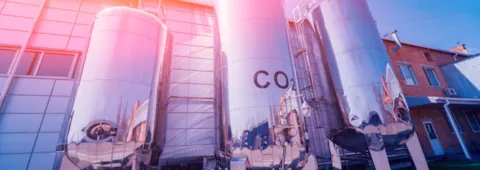CO2 CFD simulation software
Joint Industry Project
The focus of the KFX CO2 joint industry project is to increase CCS safety by bringing new capabilities to the software, including detailed simulation of complex thermodynamics and heat transfer processes and dry ice formation caused by a release of liquid CO2.
Background
The research and development of carbon capture and storage (CCS) technologies is a strategy for reducing global CO2 emissions from industry and power generation. For a wider deployment of CCS infrastructure, safety is crucial. Reliable consequence models are needed for safety assessments and design of barriers. To ensure the highest standards for design of CCS infrastructure, it is critical to have tools that simulate what actually happens if accidents occur.
When processing, transporting and storing massive quantities of highly concentrated CO2, there is a risk of hazardous releases of CO2 into the atmosphere. Sources can be blowdown vents or accidental releases from process equipment, pipelines and storage tanks, which contain large inventories and are often located near densely populated areas.
CO2 is heavier than air and will replace air near the ground. Releases of CO2 will therefore typically follow the contours of the terrain and accumulate in pits, valleys and other lower-lying grounds and consequently represent a significant hazard in these areas.
Challenge
CO2 is typically stored as liquid and can potentially cause multi-phase flow, including dry-ice formation and sublimation when released. A dense CO2 gas cloud follows the ground and displaces air. Dry ice deposits at the ground and sublimates. The complicated flow physics and thermodynamics impact the dispersion pattern significantly and must be captured by the models in KFX.
Objective
The focus of the project will be on the modelling and validation of the complex thermodynamics and heat transfer processes for release of liquid CO2. This includes the dry ice formation of released CO2 in atmosphere, deposit of dry ice (solid CO2 particles) on the ground and in complex geometries, sublimation of dry ice, when also accounting for wind conditions. In addition, condensation of water in the surrounding air due to the low temperatures will be included as part of dispersion modelling.
The objective is to further develop KFX for this purpose and bring detailed simulation capabilities to KFX, supporting a new level of safety for CCS infrastructure.
Outcome
At the end of the project, there will be a commercially available KFX version with CO2 capabilities providing a solid basis for improved CCS safety and for finding cost-effective technical solutions for design.
Project status
The JIP included Equinor, TotalEnergies and DNV as partners.
The project is now completed, and the resulting developments to support advanced CFD modelling of CO2 have been included in the KFX 7.0 release.
For more information, please visit the corresponding application description Consequence modelling of carbon dioxide with KFX.
